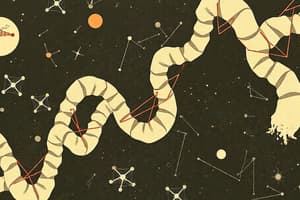Podcast
Questions and Answers
What distinguishes essential amino acids from non-essential amino acids?
What distinguishes essential amino acids from non-essential amino acids?
- Essential amino acids are always derived from complex proteins.
- Essential amino acids account for the majority in proteins.
- Essential amino acids must be obtained from the diet. (correct)
- Essential amino acids can be synthesized by the body.
Which type of protein yields amino acids upon hydrolysis?
Which type of protein yields amino acids upon hydrolysis?
- Complex protein
- Derived protein
- Simple protein (correct)
- Collagen protein
How are amino acids classified?
How are amino acids classified?
- As essential and non-essential (correct)
- By their solubility in water
- According to their charge
- Based on their molecular weight
What is a common characteristic of non-essential amino acids?
What is a common characteristic of non-essential amino acids?
Which of the following is an example of a complex protein?
Which of the following is an example of a complex protein?
What do peptides represent in the context of protein?
What do peptides represent in the context of protein?
What is represented by a glycoprotein?
What is represented by a glycoprotein?
Which statement is true regarding the body's ability to produce amino acids?
Which statement is true regarding the body's ability to produce amino acids?
What is one of the fates of amino acids and peptides after absorption in the small intestine?
What is one of the fates of amino acids and peptides after absorption in the small intestine?
What characterizes Kwashiorkor among protein-energy malnutrition conditions?
What characterizes Kwashiorkor among protein-energy malnutrition conditions?
How does excessive protein intake relate to heart disease?
How does excessive protein intake relate to heart disease?
Which of the following is NOT a symptom of Marasmus?
Which of the following is NOT a symptom of Marasmus?
What effect does high protein intake have on calcium excretion?
What effect does high protein intake have on calcium excretion?
What is the recommended protein intake percentage of total food energy?
What is the recommended protein intake percentage of total food energy?
Which dietary change may help improve conditions associated with heart disease?
Which dietary change may help improve conditions associated with heart disease?
For individuals with chronic kidney disease, what dietary modification may be beneficial?
For individuals with chronic kidney disease, what dietary modification may be beneficial?
What is a common misconception among athletes regarding protein powders?
What is a common misconception among athletes regarding protein powders?
What is the protein RDA for adults expressed in grams?
What is the protein RDA for adults expressed in grams?
Which type of protein contains all nine essential amino acids and is typically of higher quality?
Which type of protein contains all nine essential amino acids and is typically of higher quality?
Which statement correctly describes partially complete proteins?
Which statement correctly describes partially complete proteins?
What is a common source of incomplete proteins?
What is a common source of incomplete proteins?
Which function do proteins perform as acid-base regulators?
Which function do proteins perform as acid-base regulators?
What role do hemoglobin proteins play in the body?
What role do hemoglobin proteins play in the body?
During times of critical illness or protein malnutrition, which condition can occur due to protein-related issues?
During times of critical illness or protein malnutrition, which condition can occur due to protein-related issues?
Which process initiates protein digestion in the stomach?
Which process initiates protein digestion in the stomach?
Which type of protein is typically derived from animals and is considered to be of higher quality?
Which type of protein is typically derived from animals and is considered to be of higher quality?
Which of the following contributes to maintaining fluid balance in the body?
Which of the following contributes to maintaining fluid balance in the body?
What type of protein combines multiple vegetable sources to provide a balanced diet?
What type of protein combines multiple vegetable sources to provide a balanced diet?
Flashcards are hidden until you start studying
Study Notes
Overview of Protein
- Essential component of every living cell in plants, animals, and microorganisms.
- Composed of amino acids and nitrogen; these are the building blocks formed during protein digestion.
Amino Acids
- Joined by peptide bonds to create various proteins.
- Classified into essential and non-essential amino acids.
- Non-essential amino acids can be synthesized by the body, while essential amino acids (9 total) must be obtained through diet.
Types of Proteins by Structure
- Simple Proteins: Hydrolyze to yield only amino acids (e.g., Albumins, Globulins).
- Complex Proteins: Composed of simple proteins and additional non-protein groups (e.g., Glycoproteins, Phosphoproteins).
- Derived Proteins: Formed from degradation products like peptides.
Protein Sources
- Complete Proteins: Contain all essential amino acids; primarily from animal sources (e.g., meats, dairy).
- Partially Complete Proteins: Contain some essential amino acids but are insufficient for growth; examples include certain fish.
- Incomplete Proteins: Low in one or more essential amino acids; typically from plant sources (e.g., grains, cereals).
Functions of Proteins
- Tissue Building: Essential for repair and growth.
- Energy Source: Can be used when carbohydrates and fats are insufficient.
- Plasma Proteins: Maintain osmotic balance in blood (e.g., Albumin).
- Defense Mechanisms: Essential for immune response; antibodies are proteins.
Protein in Acid-Base Balance
- Proteins act as buffers by attracting and releasing hydrogen ions (H+) to maintain pH levels (normal range: 7.35 - 7.45).
Protein Transport Functions
- Some proteins carry nutrients and facilitate oxygen transport via hemoglobin.
- Lipoproteins transport lipids; other proteins can act as membrane pumps for transporting vitamins and minerals.
Fluid Balance Regulation
- Proteins generally remain in blood vessels; however, during illness or malnutrition, they may leak, attracting water and causing edema (swelling).
Digestion and Absorption of Proteins
- Begins in the stomach, where protein is hydrolyzed into polypeptides by HCL and enzymes; further cleaved by pancreatic enzymes.
- Amino acids are absorbed in the small intestine and can either enter circulation, convert to other amino acids, or provide energy.
Protein in Food
- Sources include casein in milk, albumin in egg whites, and gluten in wheat.
Protein Deficiency
- Protein-energy malnutrition (PEM): Insufficient dietary protein leads to conditions like Kwashiorkor and Marasmus.
- Kwashiorkor: Characterized by edema, muscle weakness, and brittle hair due to severe protein deficiency.
- Marasmus: Results from lack of energy and protein, leading to extreme weakness, muscle wasting, and growth retardation.
Health Implications of Protein Intake
- High animal protein intake may increase heart disease risk due to saturated fats.
- Plant proteins may lower risks of certain cancers, while high intakes of red and processed meats are linked to some cancers.
- High protein intake may increase calcium excretion, affecting bone health; a calcium-to-protein ratio of > 20:1 is deemed protective.
- High protein diets increase workload on kidneys, which could accelerate deterioration in those with chronic kidney disease.
Protein Recommendations
- Protein intake should constitute 10-35% of total energy.
- Recommended dietary allowance (RDA) for adults: 0.8 g/kg of body weight; higher for infants/children.
Protein Powders
- Commonly used by athletes to enhance muscle growth, but muscle building requires physical activity rather than supplementation alone; excessive protein does not necessarily yield greater muscle growth.
Studying That Suits You
Use AI to generate personalized quizzes and flashcards to suit your learning preferences.




